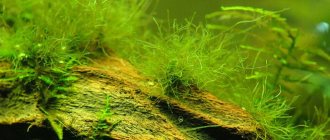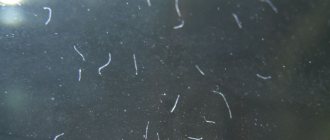- How do snails appear in an aquarium?
- Why are they harmful?
- Getting rid of uninvited guests
- spring-cleaning
- Chemistry
- Natural enemies
- Traps
Have you ever kept snails in your aquarium, but they appeared on their own? Or maybe just a few previously inhabited specimens have proliferated and are threatening the ecosystem of the entire reservoir? Such situations arise quite often even among experienced aquarists. Snails are able to benefit the aquarium by eating leftover food and parasitic algae, but once they multiply, they pose a serious threat to other inhabitants of the aquarium. Let's look at the harm caused by an abundance of coils and how to get rid of snails in an aquarium.
How do snails appear in an aquarium?
For most novice aquarists, the appearance of snails comes as a complete surprise. If you did not specifically buy snails and put them in the aquarium, this does not guarantee that they will not appear in it. In most cases, snail eggs are sold with poorly processed seaweed or may be found in soil. When you start the aquarium, they quickly hatch and begin to breed.
The best part is that these uninvited guests are the hardiest species in the aquarium. Unlike fish, they are not afraid of changes in water temperature, lack of food and pollution, but they reproduce at a high speed and with just one pair of snails you will get hundreds of new inhabitants in a couple of months.
Useful:
Many people mistakenly believe that snails can attack young fish or small fish. In fact, regular reels are completely harmless to healthy fish. They "stick" to the fish when it is seriously ill or dying.
Prevention of occurrence
Of course, it is worthwhile to engage in extermination, but also in preventing the appearance of parasites.
To prevent the spread of snails, you need to keep the aquarium clean.
Common simple rules that should be followed to make residents comfortable:
- clean the soil once a week;
- do not overfeed the fish;
- control the condition and temperature of the water, especially if chemicals were used;
- buy all kinds of traps and baits for parasites;
- get a few fish that eat shellfish;
- periodically review the decor of the aquarium;
- Having purchased new plants or devices, check them for the presence of parasites . It's better to send them to quarantine. After a while, if no one is hiding in them, you can immerse them in the aquarium;
- occasionally limit the fish in food, then they will eat snails with great appetite.
DEVICE AND PRINCIPLE OF OPERATION OF AN EXTERNAL FILTER FOR AQUARIUM
NITRATE FILTERS FOR AQUARIUM
FOAM SEPARATOR FOR MARINE AQUARIUMS
REVIEW OF THE BEST INTERNAL FILTERS FOR AQUARIUM FOR 2021
THE BEST FILTERS FOR AQUARIUM IN 2021
How are they harmful?
A controlled snail population in an aquarium is beneficial. But the uncontrolled increase in the number of the most common red and black reels is the cause of the following negative phenomena:
- The aesthetic appeal of the aquarium is reduced - you must admit, hundreds of crawling snails of various sizes do not look particularly attractive. Especially if they also stick to the walls, blocking the view of the fish. Some of the snails secrete a lot of mucus, which accumulates on the walls and spoils visual perception.
- The aquarium ecosystem is harmed - too large a population of snails eats food, which sinks to the bottom, leaving bottom fish and other aquarium inhabitants hungry.
- The risk of disturbing the balance of the established ecosystem increases. Snails siphon the soil and eat most waste, but the abundance of shells in the aquarium upsets the balance and can cause diseases in the fish.
Additionally, snails are carriers of bacteria and infections, so if your fish start to get sick, after taking treatment measures, we strongly recommend that you evict the entire snail population from the tank.
The benefits and harms of illegal immigrants
Melania is the most common type of mollusk. Most often you can find it in an aquarium.
Even one melania snail placed in an aquarium can create its own colony. Melania is hermaphrodite.
As for beneficial qualities, this invertebrate representative is an excellent cleanser. It clears the bottom of food debris, dead decomposing fish, and scales left over from eggs. In addition, aquatic inhabitants constantly stir up the soil, which aerates it. And this, in turn, prevents the occurrence of stagnation. But these beneficial actions are carried out only when there are not too many small snails. Otherwise, they cause only harm.
What is characteristic is that their numbers are almost impossible to control , since they multiply rapidly. This happens especially quickly in aquariums with sandy soil.
Coils of various types are the second most popular illegal shellfish, which are often found in the form of eggs or tiny snails that grow quickly and begin to reproduce further. Amazingly tenacious species!
Snail Coil is a well-known repeat illegal immigrant.
When numerous coils begin to lack food, they begin to actively eat the vegetation in the container. In addition, they emit ammonia in large quantities, and this affects the health of the remaining inhabitants of the aquarium. It is also known that snails spread some diseases that are not dangerous for them, but can kill fish.
The appearance of the aquarium also loses its attractive appearance. The water becomes cloudy, the walls and decorations are covered with numerous coils.
spring-cleaning
This is the simplest and most radical way to get rid of black snails and melania snails in an aquarium. It is necessary to place the fish in a separate tank, drain the water from the aquarium, remove algae and soil and wash it thoroughly. Then boil all decorative items, fill in new soil and plant new algae, since snail eggs could remain on the old ones.
This method is effective but unsafe for fish. You will have to restart the aquarium and wait until the ecosystem stabilizes, and this is a lot of stress for its inhabitants.
Myth:
Snails eat algae, and in a few days a large colony will destroy half the flora of the aquarium. In fact, coil snails cannot eat such hard food, but switch to soft and dying algae leaves when they lack their usual food.
Myths about snails
Snails pollute the aquarium Quite the contrary, aquarium snails eat waste, clean surfaces, and destroy algae. This myth most likely stems from the fact that snails thrive in neglected aquariums that are overfed and poorly maintained.
Snails can kill small fish Snails are omnivores and will eat anything they can get their hands on. When the fish dies or is already very weakened, the snails instantly gather for a feast. The aquarist sees that the fish is lying on the bottom and is being eaten by snails, but they are not to blame for its death. With a little thought, it’s easy to understand that a slow-moving snail cannot pose any danger to healthy and playful fish.
Snails spoil plants Some snails, especially from nature and local water bodies, can damage plants. But the majority of aquarium snails do not harm plants in any way. Snails have small mouths adapted for scraping surfaces, while higher plants have a hard surface. The origin of the myth is easy to understand - snails constantly eat old, dying leaves and it seems that they are the ones who killed them.
How to control the population of aquarium snails:
- Don't overfeed
- Clean the soil regularly
- Get catfish or shrimp so that they also eat algae
- Get some fish that eat snails
- Turn over driftwood and decor
- Use snail traps
- 7. Check new plants and decor for eggs and snails
- Never use plants or decor from local bodies of water.
- Do not feed the fish for a couple of days, they will be more willing to eat snails
- Watch your water if you use chemicals
Chemistry
Pet stores sell drugs that can quickly destroy the entire snail population in an aquarium. You just need to choose a product depending on the type of mollusks that have occupied the tank, and use it according to the instructions.
But many do not risk using store-bought chemicals, because this greatly upsets the balance of the reservoir’s ecosystem and can harm the health of its other inhabitants.
In addition, you will have to promptly remove dead snails from the aquarium so that they do not have time to decompose and cause an outbreak of diseases.
Professional products
Aquarists often use chemicals against shellfish.
However, this method has side effects:
- The death of a large number of individuals can cause rapid proliferation of bacteria.
- These drugs can be harmful to microorganisms in the filter.
- It is unlikely that the drug will work against the entire population.
- Useless against caviar.
Before you purchase a particular drug, you should read the instructions for it. Copper is often included in the composition. This element is dangerous for fish and shrimp.
Among the industrial preparations you can purchase in aquarium stores:
Sera Snailpur
2 hours after using the drug, replace 1/3 of the aquarium water, while simultaneously removing paralyzed snails. Then the water is treated with Sera Aqutan conditioner in a dosage as for a full aquarium, and fresh water is added to the full volume. The treatment is repeated after 2 weeks to remove the juveniles that have hatched from the eggs.
ZMF Limnacid
A potent remedy against snails, hydras, planaria. The drug requires strict adherence to dosage. Before use, remove adsorbents from the aquarium and replace 1/3 of the aquarium water with fresh water.
JBL Schnecktol
After using the drug according to the instructions, dead individuals are removed from the aquarium. The drug is notable for being harmless to tower snails. The product is used at the rate of 25 ml per 100 liters of water.
Natural enemies
To combat overgrown snails, fish are used... Or another type of snail. Yes, there are predatory mollusks that eat smaller relatives, for example, the Helena snail.
As for fish, tetradon, clown loach, macropod, gourami or catfish will help control or completely destroy the shellfish population.
The main thing is that when adding a predator, pay attention to whether it is able to get along with other fish and whether it will harm them. For example, tetradon and catfish can bite the fins of “peaceful” fish, and the clown loachfish becomes aggressive and can kill young animals of small breeds. As for the Helena snail, it is harmless to fish, but after exterminating the snails, it does not easily transition to regular food.
"Fish" method
Some types of fish love to eat snails. Effective against mollusks:
Green tetradon
This fish looks very cute, but has an extremely aggressive character. The small tetradon (about 15–17 cm in length) does not allow any of its neighbors to escape; it readily eats snails, even ampularia. By the way, tetradon is a close relative of the puffer fish.
Dwarf tetradon
This fish grows teeth quickly. She is forced to adjust their length by grinding them off on snail shells. By introducing a dwarf tetradon into an aquarium, within a few days you can expect the destruction of the entire population of coils and physical specimens.
Eight tetradon
A very aggressive aquarium inhabitant. Although it is small - only 10 cm in length, one individual will require at least 50 liters of an aquarium. The eight tetradon is notable for the fact that it even eats melanium.
Dwarf gourami
The length of this fish rarely exceeds 4 cm. Therefore, gourami is suitable for small aquariums in order to combat small snails and their eggs.
Ancistrus catfish
Cleans the walls of the aquarium and decorations on which snails lay eggs, thereby regulating their numbers.
Traps
If you are against harsh measures and don’t want to let a lot of “strangers” into your pets, but are looking for how to get rid of red snails in an aquarium, then just install shellfish traps. This is done like this:
- Scald a cabbage leaf, cucumber or salad with boiling water.
- Place the delicacy prepared in this way on a clean flat plate.
- We put it all in the aquarium overnight.
The listed products are the favorite delicacy of snails. Most are guaranteed to slide onto it and all you have to do is pull out the plate and throw away the snails.
Important:
The trap described above will not work if you have catfish in the aquarium - they will happily eat all the bait themselves. Therefore, you can take a plastic bottle, make holes on it, put the bait and put it in the tank overnight.
How to fight
Methods for controlling snails in an aquarium are divided into chemical, biological and mechanical . If you use two of them at once, the problem of overpopulation will be solved faster.
When vegetation is present in the aquarium, using each of the above methods to control shellfish will be much more difficult. And if you remove the algae for a while, there is a danger of introducing eggs into the aquarium on the leaves again.
Chemical control
There are special reagents to combat snails. Purchase them at pet stores or online. But the use of such drugs has many side effects. Therefore, they should be used as a last resort.
Chemical control of snails in an aquarium upsets the balance in the aquatic environment. The simultaneous death of a large number of mollusks leads to a bacterial outbreak. This, in turn, significantly changes the composition of the water and leads to fish diseases.
There is a high probability that some of the mollusks will survive this treatment, after which they will begin to eat the remains of their relatives.
Before getting rid of coil snails in an aquarium using a chemical, you should carefully study the recommendations for its use. Some of the reagents are toxic to the rest of the aquarium inhabitants due to their copper content. Therefore, all living creatures are transplanted into another container before the procedure.
It is permissible to use preparations with chlorine if you plan to completely restart the aquarium. Before this, all living creatures and algae are removed from the aquarium, after which disinfection is carried out. Then the soil should be boiled, and the remains of the snails should be removed manually.
Manual cleaning
Manual cleaning of the aquarium from snails is considered the simplest and most effective. Shellfish are collected from all visible surfaces, which is easier to do in small containers of up to 40 liters, where algae do not grow too thickly.
It is advisable to collect large individuals at least 2 times a week. Getting rid of small snails in an aquarium is much more difficult: you have to crush them right on the spot.
It will not be possible to collect all the mollusks by hand: small snails and eggs will remain in the soil and on the plants. This method requires time and attention, but is considered ineffective, especially when there is a lot of algae.
Lures and traps
A safe way to control snails in an aquarium is to use traps.
Place a piece of banana peel, a piece of fresh cucumber, a leaf of lettuce or cabbage scalded with boiling water on the ground. After a few hours, the coils will crawl from all corners of the aquarium to the treat offered to them. When the banana peel is completely covered with shellfish, carefully remove it, remove the shellfish and repeat the procedure.
It is impossible to completely get rid of coil snails in this way, but it is quite possible to significantly reduce their numbers without making special efforts. The main thing is to make this procedure regular.
Catfish and some fish sometimes make it difficult to catch snails with bait. Therefore, it is placed in a plastic container, in the bottom of which holes are burned with a hot nail. The container with bait (preferably scalded) is closed with a lid and placed in the aquarium. In the morning it will remain to be cleared of a large number of snails.
If you clean such a trap once every 2-3 days, within a month the number of mollusks will decrease tenfold.
Biological methods
It is possible to get rid of coil snails in an aquarium with the help of their natural enemies.
There are fish that naturally eat shellfish. It is enough to put them in the aquarium. But you shouldn’t feed them too actively so that they start eating snails.
Tetradon is a big fan of snails, but has a quarrelsome nature, which in a community aquarium will lead to constant conflicts. Clown botsia, macropods and some gouramis are not too aggressive.
Ancistrus catfish does not feed on mollusks, but enjoys eating their eggs. And this further reduces the total number of shellfish. To make it more convenient for catfish to get to the clutch, you should regularly turn over stones, driftwood and other decor where eggs are most often laid.
The crustacean Macrobrachium is also a good shellfish eater. There are also predatory species of snails, for example Antentome Helena, which eat their relatives. Their popularity has grown in recent years, making them easy to purchase.
The number of Helena snails is calculated based on 1 individual for every 10 liters of water, if there is not a lot of algae in the aquarium. But they are not interested in mollusks that are too small; they choose the largest ones to eat.
Flushing
This is the most labor-intensive way to get rid of snails in an aquarium, requiring a complete restart. But if certain conditions are met, it is the most effective.
All inhabitants of the aquarium are placed in another container, and the plants and stones are thoroughly washed under running water. In this case, the leaves need to be wiped with a cloth to get rid of stuck eggs.
The soil needs to be boiled in a pan of water, then cooled, washed and sifted, removing the remains of the snails. Then the aquarium is washed well and started up according to the general rules.
Biological control
This method involves introducing shellfish enemies into the aquarium - creatures that can remove parasites by eating them. Natural enemies include:
- The Helena snail is an aggressive mollusk that eats smaller relatives. Helena is harmless to fish.
- Cichlids, gouramis and dwarf tetradons - these phenotypes feed on gastropods, tetradons are especially well established. These fish have bony plates and easily bite through the protective shell of snails.
- Macrobrachium is an arthropod that will help kill snails.
Chemical method
A time-tested chemical remedy for snails is ordinary salt. Gastropods cannot tolerate salt water, their body slowly dehydrates, and they die within 24 hours. Before adding salt to the aquarium, fish and plants are caught from it. It is better to use aquarium salt, since table salt may contain other elements, such as iodine.
When using Aquacons against snails, you need to be careful and follow the instructions.
Industrial preparations for killing snails contain copper. They must be used with great caution and as a last resort, because after this the aquarium will have to be restarted. It is often written on the packaging that these products are not dangerous and harmless to other inhabitants of the underwater world, but for shrimp and crayfish it is 100% fatal . Aquacons anti-snail conditioner has a detrimental effect on barbs, catfish and other types of bottom fish.
Many types of plants also do not like chemicals; even a short stay in the solution can slow down their growth for a long time and ruin their appearance.
After chemically cleaning the aquarium from snails, the soil and decorations are disinfected, the plants on which caviar may remain are treated with a solution of potassium permanganate.
Where do snails come from?
For those fish keepers who intentionally purchased shellfish, there is no question about where the snails in the tank came from. However, if there were no conscious purchases, then the question is quite logical - many aquarists, having discovered a lot of snails in the tank, are at a loss. The answer is simple - parasites in an aquarium are introduced from the outside, arriving in an artificial reservoir along with untreated substrate or living flora. Therefore, in order not to fight pests later, before immersing them in the aquarium, the plants are kept in a weak solution of potassium permanganate, which is destructive for small mollusks.
In other words, gastropods appear in two ways: with the help of an aquarist, or by penetrating along with vegetation. If the conditions in the tank are favorable, then the uninvited guests begin to multiply rapidly.
How to remove snails to restore the balance of the ecosystem?
A snail is a mollusk that can be hermaphrodite or heterosexual. Those that appear unexpectedly in an aquarium are hermaphrodites (which means it is impossible to keep track of reproduction) and lay eggs.
Such parasites enter the reservoir on the leaves of purchased plants. To avoid such trouble, it is recommended to soak the shrubs in a manganese solution before planting. This will destroy all the eggs laid on the greens.
To reproduce one such mollusk, a neutral environment and the remainder of fish food will be enough. From 1 individual in the tank there will be up to 100 if measures are not taken in time.











